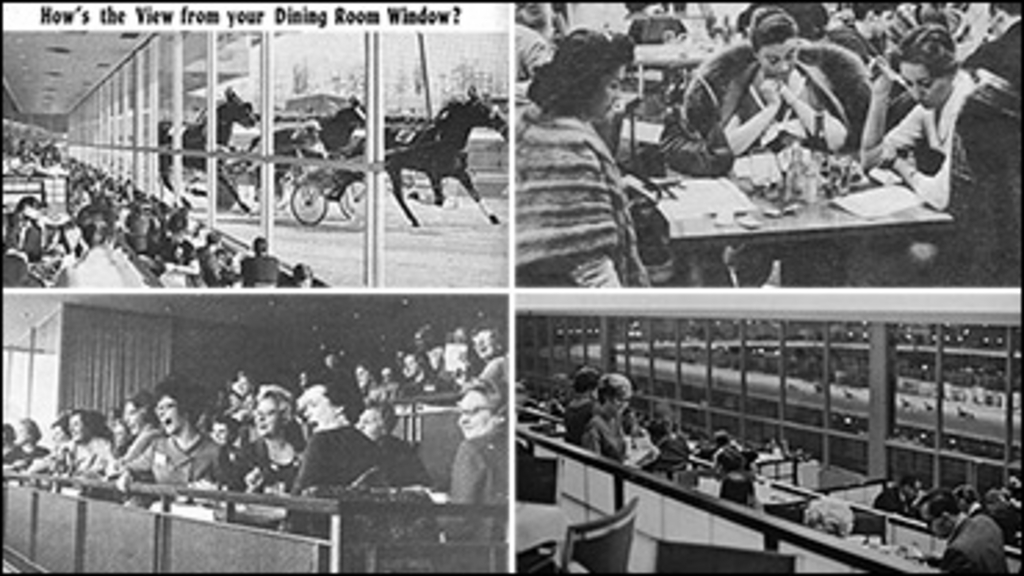
In the current edition of Rewind, Robert Smith recalls an important happening in the past of harness racing as the sport progressed and grew. He remembers the coming of the clubhouse as a standard part of nearly all racetracks. His piece also includes a number of old photos of clubhouse scenes from days gone by.
In the early days of harness racing, fans in attendance were there mainly to watch the races and of course to bet on their favourite horse when the opportunity afforded itself. They were accustomed to high temperatures and humidity in the summer and were willing to bundle up against the late fall winds and sometimes rains. Grandstands were open and often in a state of disrepair, especially at small-town venues. But that was the way it was, and people who loved the sport and seeing the horses in action took it all in their stride. They didn't expect to be fed or entertained beyond the minimal fare such as a hot dog or a bag of popcorn. On the U.S. side, the availability of a nice cold draught beer in a paper cup was a possibility as well at many locations.
As time went on, more of the entertainment value of racing was taken into consideration and with the changing times came new and innovative ways of attracting and providing more services for the racing public. With the advent of night racing, people were treated to better facilities and the surroundings gradually began to change. Better programs,food and beverages and other amenities appeared.
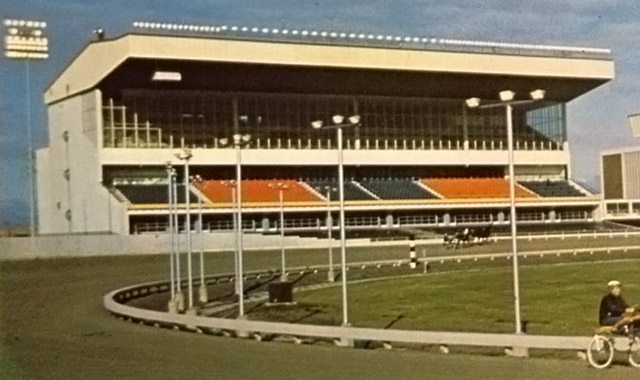
The upgraded modern version of the Blue Bonnets clubhouse from a 1969 photo (Hoof Beats)
By the decade of the 1960s a huge change in creature comforts was well underway in the sport in general. As an example, in 1960 at a cost of $7,300,000, Blue Bonnets Raceway in Montreal made a major step toward the future. Under the direction of Jean Louis Levesque this huge expenditure was spent on stabling and grandstand improvements. Race fans were able to dine in comfort and even have their wagers made by messengers, a true luxury. Another great new feature was the flashing of the "picture finish" on closed circuit TV within 45 seconds of the completion of a race. It was modern technology at work.
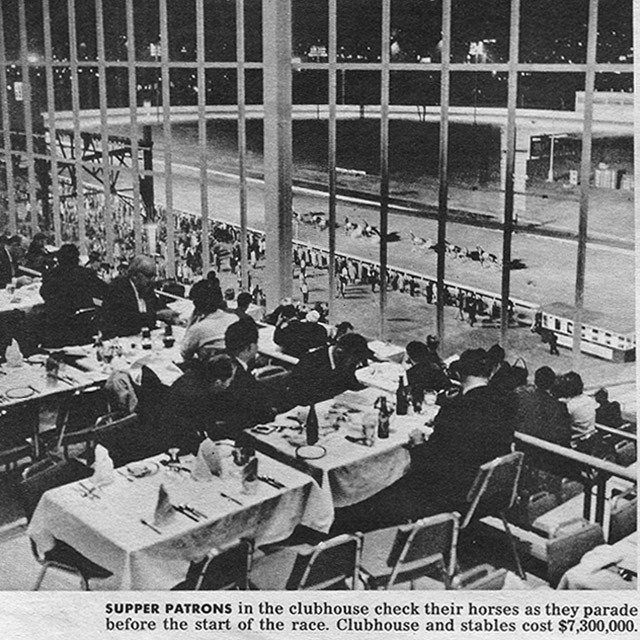
Above photo shows fans watching the post parade at Blue Bonnets Raceway in 1960 following a huge renovation that resulted in posh new surroundings for racegoers. This was a giant step forward for the sport as it emerged from its Country roots to a major spectator sport. Notice the reference to 'supper' was used.
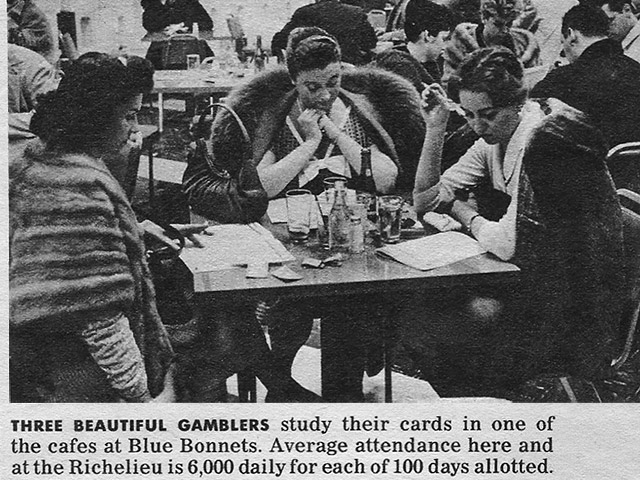
These ladies are enjoying the new facilities at Blue Bonnets following the 1960 upgrade. Check out the fur coats.
By 1960, both Blue Bonnets and Richelieu Park had an average nightly attendance of 6,000 under the lights for the 100 days allotted to harness racing. On Sundays, matinee crowds of 16-18,000 were not uncommon. Strangely, at this same time no night racing yet existed in Ontario but agitation was growing as more and more groups lobbied Premier Leslie Frost. He insisted that there would be no night racing in his Province. He said "In my view enough gambling is done in the daylight." In June of that year The Peterborough Driving Club held a night meet in June, hoping to provide a test case. Club President Orville Fallis stated "There is really no law against it."
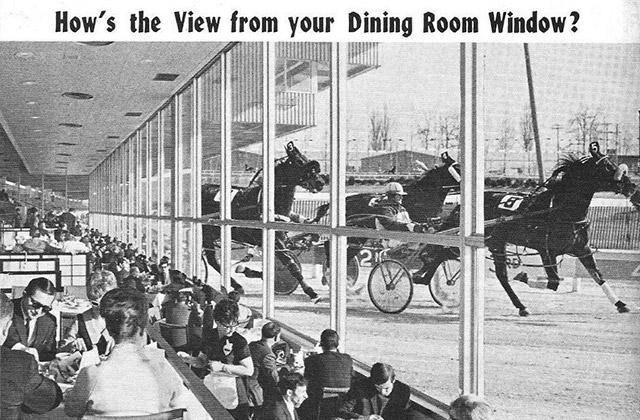
This 1969 shot used as part of an Ontario Jockey Club ad shows a large group of raceway patrons watching racing from the comfort of the Greenwood Clubhouse, then a fairly recent amenity. If I were a betting man I would wager at least a nickel that the driver leading the field might be Keith Waples. (OJC Files)
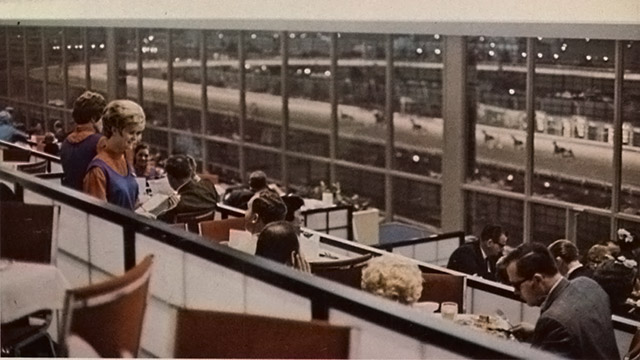
A view of the Greenwood clubhouse as it looked in 1969. Anyone remember it? (Hoof Beats)
The practice of building tiered clubhouses provided an excellent vantage point for viewing the races. Patrons could be comfortably seated while dining and have an unobstructed view of the entire race from start to finish. The age old problem of having your view blocked by fans who rushed out at the end of a race was solved forever. Many tracks became known for the quality of their food and top chefs were hired to provide a much higher level of cuisine than was once associated with racetracks.
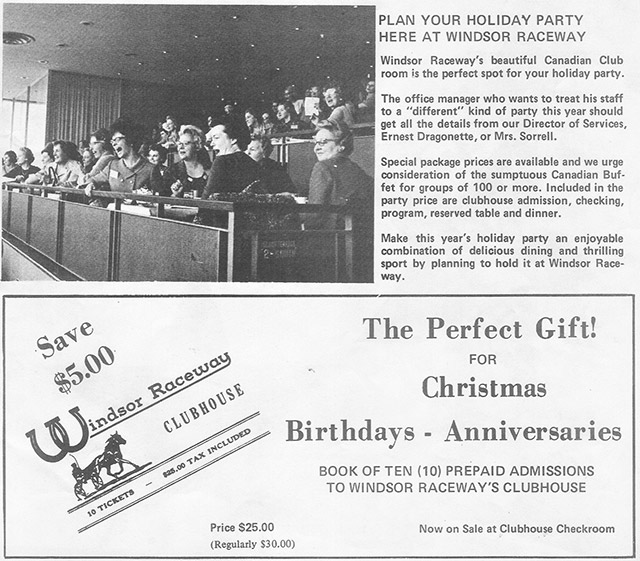
At Windsor Raceway the Canadian Club dining room, named after the famous brand of whiskey distilled in nearby Walkerville, was an extremely popular spot for many years. Work groups, family get-togethers and other social gatherings were held there especially at holiday time. In later years when the track was under the ownership of Mr. Tom Joy, he promoted a highly successful prime rib dinner which I believe went for the princely sum of $3.99. Mr. Joy was a great promoter and theorized that what he might lose on the dinner cost would soon be recovered once the patrons were through the door.
Quote For The Week: "Spending time with children is much more important than spending money on children" from Anthony Douglas Williams
Who Is It?
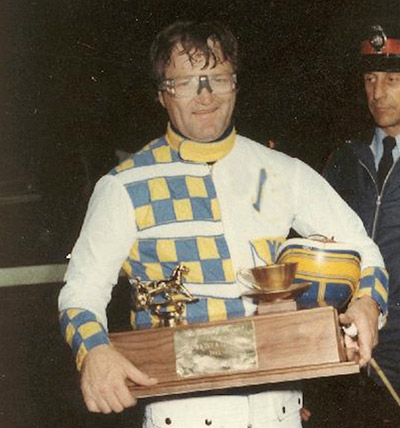
Can you put a correct name on this gentleman?
Who Else Is It?
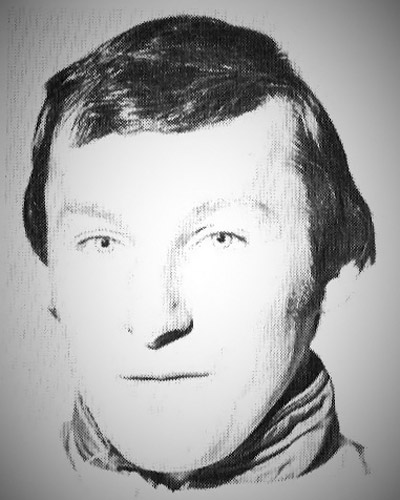
Can you figure out who this young lad is? Be sure to send in your guess and also stay tuned for the correct answers in the coming week.
A Sign Of The Times (I included this only because of what the current COVID situation has done to everyone's daily lives)
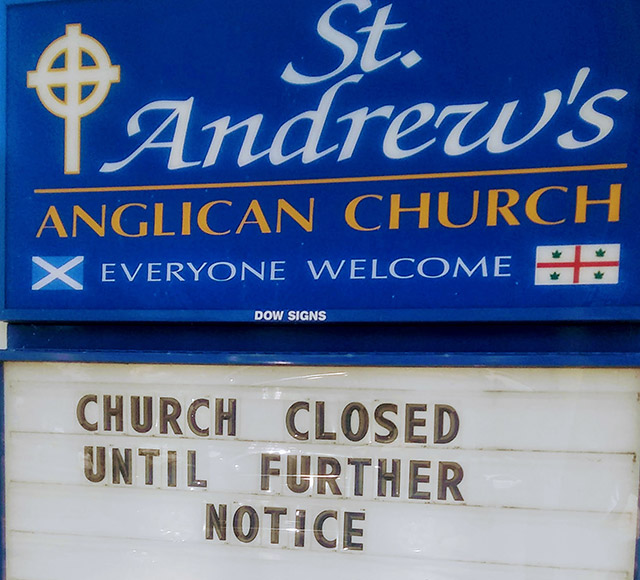


This week's pictures were a
This week's pictures were a "breeze" for the experts. The upper photo was the great Maritime reinsman Mike MacDonald holding the coveted Gold Cup & Saucer Trophy. In the lower picture was Barry "Peewee" Drury. Thanks to everyone for your guesses and also to those who shared their clubhouse memories. Your comments are appreciated and always add to the story. Please keep them coming.
I have wonderful memories of
I have wonderful memories of the Greenwood clubhouse. My holidays coincided with Grand Circuit so in the early 70's we would reserve a table for a few nights. Standardbred people are always friendly so one night we struck up a conversation with K.D. Owen at the next table. He was a wealthy oil man from Houston, Texas and had a big stable under the guidance of Archie McNeil. Unfortunately I didn't follow him to the windows when his Tar Heel colt 'Hurly Burly' won a division of the Count B and paid $229.00! You had to wear a tie and jacket to get in.
At Mohawk in the fall you had to phone at 10 AM Sunday morning to reserve a table for the next Saturday night. There was a wonderful hostess but I can't remember her name.
I remember when you were not
I remember when you were not allowed in the Club House unless you wore a suit or a sport jacket and you had to where a tie. Great pictures Robert! 'Who is it' is Mike MacDonald. He could drive a horse with the best of them in his day. 'Who else is it' is Barry “Pee Wee” Drury. Along with his wife Pat worked for Ron Waples for several years. Two of the hardest working people I know. Their son Jonathan Drury is one of the top catch drivers at Mohawk.
Mike Mcdonald - 2nd photo
Mike Mcdonald - 2nd photo Barry Drury.
Mike McDonald, Pee Wee
Mike McDonald, Pee Wee
Who is it? Mike MacDonald
Who is it? Mike MacDonald with the Gold Cup and Saucer in Charlottetown. Nice stories. Regards, Bert Clish
No. 1 Michael Macdonald
No. 1 Michael Macdonald
2nd pic Barry Drury
2nd pic Barry Drury
Who is it? Mike MacDonald
Who is it? Mike MacDonald holding the Gold Cup & Saucer Trophy.
Who else is it? Barry Drury.